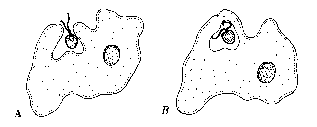Cell Transport
Movement of Materials In & Out of
Cells
Processes that cells use to move molecules across their membranes are:
Passive Transport: Movement of molecules from
high to low concentration, using no energy.
A. Diffusion- Does not use energy.
B. Osmosis- Does not use energy.
C. Facilitated Diffusion- Does not use energy.
Membranes in the cell membrane pick up molecules & carry them across the
membrane from high to low concentration. (Animation)
The Following are Energy Requiring Processes:
D. Active Transport: A way cells get needed materials
by using energy to move materials against a concentration gradient (molecules
are moved from low to high concentration (against diffusion)).
Active Transport is used in movement, breathing, digestion, thinking, etc..
E. Endocytosis: (Endo - means to bring in) Energy
requiring process where cell membrane surrounds molecules, forming a pocket
which becomes a vacuole in the cytoplasm. (Animation)
Types of Endocytosis:
a) Phagocytosis: Membrane surrounds large particles,
forms a pocket, then vacuole. This is how an amoeba or white blood cell feeds.
(Animation)

b) Pinocytosis: Literally means cell drinking.
Membrane surrounds a liquid, forms a pocket, then a vacuole.
F. Exocytosis: (Exo - means to take out) Energy
requiring process where a vacuole containing large molecules joins with the
membrane, makes an opening, and squeezes the molecules out of the cell. (Animation)
(Animation)

Slichter


